

Artikel ini merupakan rangkuman dari penelitian dan data pada situs ini

41% perempuan dan non biner mengalami kekerasan seksual secara verbal dan fisik di tempat kerja
Rata-rata, data global menunjukkan bahwa 30% lebih dari 2.000 profesional media disurvei oleh WAN-IFRA Women in News pada Oktober 2020 sampai September 2021 mengalami kekerasan seksual secara verbal dan atau fisik di tempat kerja. Ketika dipilah berdasarkan gender, angka ini meningkat hingga 40% dari perempuan dan non biner dan 12% responden laki-laki mengaku pernah menerima kekerasan seksual.
Yang mengkhawatirkan, rata-rata 1 dari 10 responden melaporkan bahwa mereka pernah mengalami kekerasan sebanyak 5 kali bahkan lebih.

1 dari 10 responden mengindikasikan bahwa mereka pernah mengalami kekerasan lima kali atau lebih
Tren lain yang mengkhawatirkan dari seluruh 20 pasar adalah keengganan untuk melaporkan kasus yang terjadi. Rata-rata, hanya 1 dari 5 kasus kekerasan seksual yang secara formal atau informal meningkat dalam organisasi media.
Juga secara konsisten di lima kawasan: tingkat respon yang diberikan oleh organisasi penerima laporan tidak memadai. Rata-rata, aksi yang diambil oleh organisasi hanya untuk setengah dari kasus yang dilaporkan. Dan ketika aksi diambil, sebagian besar adalah respon umum yaitu “peringatan kepada pelaku”.
Pelaku kekerasaan seksual yang paling banyak disebut adalah sesama rekan kerja (39,3%), lalu manajemen yang lebih tinggi (18,9%) atau atasan langsung (19%).
Pelecehan Verbal untuk wanita
Tingkat pelaporan berdasarkan kawasan juga menunjukkan beberapa variasi, dengan Amerika Tengah menunjukkan tingkat pelaporan tertinggi yaitu 26% dan kawasan Arab yang terendah dengan 15%
Ketika ditanya apa yang membuat pelaporan tidak diberikan, tanggapan luar biasa menunjukkan rendahnya pemahaman atau kesadaran tentang cara-cara pelaporan kejadian, dan ketakutan akan dampak yang muncul jika kejadian itu dilaporkan. Hanya 11% dari responden yang mengetahui jika organisasi mereka punya kebijakan tentang kekerasan seksual.
Selama lebih dari 12 bulan studi ini, WAN-IFRA Women in News melakukan wawancara mendalam dengan 85 eksekutif senior media dari 18 - 20 negara target. Tren secara konsisten menunjukkan hilangnya hubungan antara persepsi eksekutif dengan realitas yang ada ketika menyangkut pemahaman tentang skala masalah di dalam organisasi media mereka atau pada industri secara umum dalam pasar khusus mereka.
43,5% dari eksekutif media yang diwawancara melaporkan bahwa secara pribadi pernah mengalami kekerasan seksual. Tetapi dalam kelompok yang sama, hanay 27% dari mereka yang menganggap kekerasan seksual masih menjadi masalah dalam industri ini. Hal ini diperparah dengan rendahnya kesadaran tentang kebijakan kekerasan seksual: 10,9% yang diwawancarai mengetahui jika organisasinya memiliki kebijakan tentang kekerasan seksual.
Rendahnya kesadaran mereka tentang besarnya masalah ini sebagian dapat disebabkan oleh rendahnya tingkat pelaporan - yang juga menunjukkan gejala dari rendahnya kejelasan bagaimana laporan dalam dilakukan juga peristiwa terjadi, sebagaimana dijelaskan di atas.
Ada langkah-langkah jelas yang dapat dilakukan oleh organisasi media untuk melengkapi tim manajemen dengan alat-alat yang tepat untuk menangani dan memitigasi kekerasan seksual di tempat kerja. Kebijakan kekerasan seksual yang jelas dalam definisi dan dapat diakses menjadi sangat penting. Pelatihan untuk manajer tentang bagaimana menangani kejadian ini dengan cara yang terhormat, adalah juga hal penting lainnya. Sebagai langkah pertama yang penting, manajer media dapat memahami lebih baik tentang besaran masalah kekerasan seksual ini dengan melakukan survei internal anonim
Seperti yang ditunjukkan dalam riset global ini, kekerasan seksual tetap menjadi masalah yang meluas di industri media.
Pelajari lebih tentang apa yang dapat dilakukan untuk menangani kasus kekerasan seksual di organisasi mediamu di sini: https://sexualharassment.womeninnews.org/en/
African media has a sexual harassment problem. But many cases of physical and verbal sexual harassment go unreported because of fear of further victimisation and a lack of confidence in management systems and interventions. When action is taken, results are often underwhelming.
WIN’s latest research, the first phase of a multi-region study, set out to collect credible information about the scale of harassment in news outlets in Africa and to establish what was being done to provide safer newsrooms.
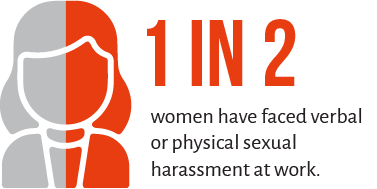
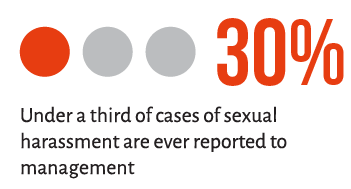
575 survey respondents, from eight countries, namely Kenya, Malawi, Zambia, Zimbabwe, Botswana, Tanzania, Uganda and Rwanda, responded to questions on sexual harassment at work - verbal and/or physical. It found:
Fear prevented many from filing formal complaints. These were the common concerns:
The absence of and lack of awareness of reporting mechanisms also explained inaction.
Almost half, 46.7%, of those surveyed said their organisation had no sexual harassment policy, 35.9% were unaware of what was in the policy and just 17.4% were aware of its contents.
Of the 32 managers interviewed 68.7% said their organisation had a sexual harassment policy - 46.7% had been trained on it.
Perhaps the biggest impedance in reporting is that the perpetrators are often managers or supervisors - people with responsibility and power. Survey respondents identified their harassers as fellow employees (in 38.8% of cases) but 22.1% of the time they were direct supervisors and in 19.4% of cases, members of higher management.
When action was taken in 57% of cases reported, the most common organisation response was to warn the perpetrator (46.2%). 14.5% of responses said training was offered and 9.7% had the case dismissed.
“The research highlights a lack of trust in the organisation, or sometimes complete failure of management and systems, to deal effectively with sexual harassment,” said Melanie Walker, WAN-IFRA’s Executive Director, Media Development and Women in News.
“This matters because the less confidence there is in an organisation’s ability to address the problem, fewer people will see value in calling it out, and so the cycle will perpetuate.” There are solutions, however, beginning with owners and managers acknowledging the problem exists and then committing to ensuring a safer working space, not just for women, but for all staff. It is vitally important to change the culture of silence around harassment. And this culture change can only come from the very top.”
In supplementary interviews with 32 media managers, we found
“There are divergent views on the scale of sexual harassment between the survey respondents and managers we interviewed. There is no simple explanation for this - but what is common is that both staff and managers have had first-hand experience of sexual harassment, and in most cases chose not to report it. This suggests fear of victimisation runs alongside a lack of confidence in management systems and any apparent remedies,” said Walker.
Women in News, which offers expert input on how to manage sexual harassment, is starting to see little victories among those media organisations that have begun to actively manage the problem - starting with adopting policies and procedures that the staff can support. “But the numbers are very small and we have a very long way to go before staff are convinced and comfortable that if there are incidents of harassment, they can report them, and action will be taken, without further victimisation,” said Jane Godia, Africa Director of WIN and an expert and trainer managing sexual harassment.
“We are still working on changing perceptions and debunking cultural beliefs that perpetuate sexual harassment,” said Godia.
Penelitian ini membuktikan bahwa perusahaan media perlu mengenali skala persoalan kekerasan seksual dan merencanakan langkah-langkah yang diperlukan untuk mewujudkan lingkungan kerja yang lebih aman.
“Upaya ini dimulai dengan diskusi terkait perilaku apa saja yang pantas dan tidak pantas dilakukan di perusahaan media masing-masing dengan secara jelas membahas masalah kekerasan seksual, termasuk menjelaskan definisinya dan perilaku apa saja yang tidak pantas, serta mengumumkan bahwa tiap karyawan berhak diperlakukan setara. Kebijakan saja tidak cukup; para karyawan dan manajer harus mendapat sosialisasi tentang prosedur yang bisa digunakan untuk menyampaikan dan meneruskan pengaduan. Tiap orang harus memahami konsekuensi dari kekerasan seksual. Lebih baik bertindak proaktif dan siap sejak dini ketimbang harus mengatasi krisis saat kasus muncul,” tegas Walker.
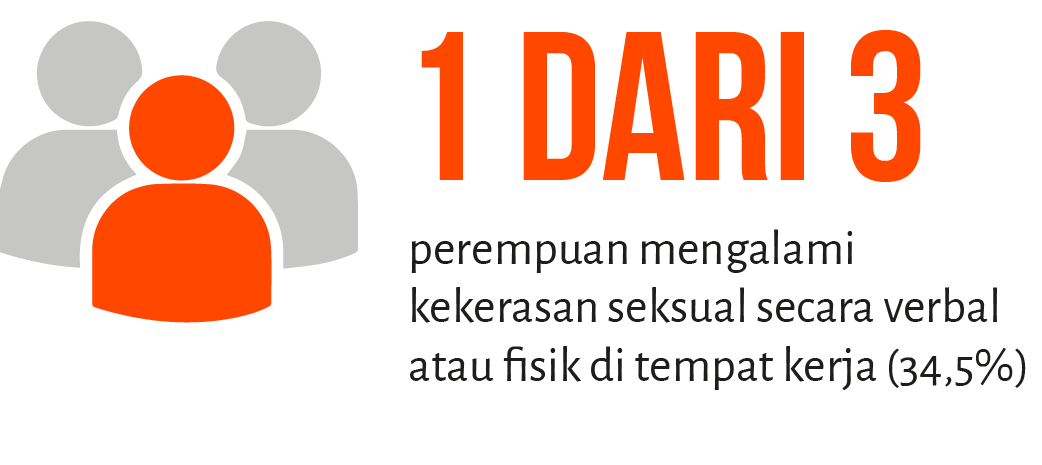
Cara organisasi media dikelola, umumnya, dipengaruhi oleh kepercayaan bahwa karyawan paham bagaimana bersikap. Namun, kenyataannya kekerasan seksual masih terjadi – terutama dialami perempuan – dan seringkali tidak dilaporkan. Dengan lebih dari satu dari enam kasus yang dilaporkan kepada manajemen, budaya diam dan ketakutan tetap ada.
Kondisi ini diperparah oleh perbedaan antara eksekutif dan karyawan dalam memandang skala masalah. Meskipun ada satu dari tiga perempuan mengalami kekerasan seksual di tempat kerja, 84,1% dari eksekutif yang diwawancara percaya kekerasan seksual bukanlah masalah dalam industri berita. Inilah kesenjangan persepsi yang signifikan.
Hasil ini adalah bagian dari studi multi wilayah yang memberikan bukti sejauh mana kekerasan seksual terjadi. Riset lengkap akan membantu pemahaman atas persamaan dan perbedaan yang dihadapi oleh media di Belahan Selatan

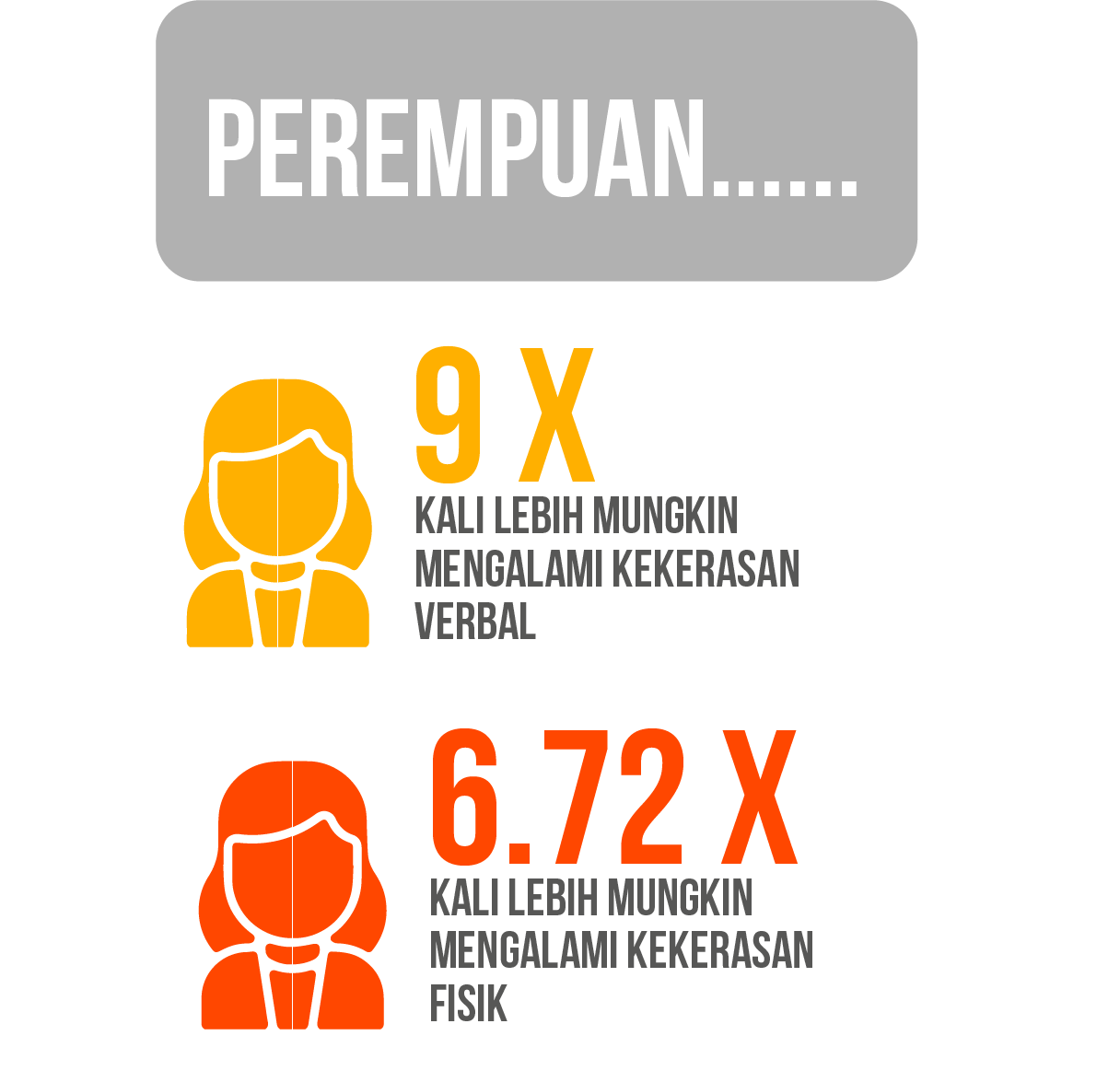
Sebanyak 494 responden berasal dari lima negara yaitu Indonesia, Myanmar, Malaysia, Filipina, dan Vietnam yang memberikan respon terhadap pertanyaan seputar kekerasan seksual di tempat kerja – secara verbal dan/atau fisik. Survey menemukan:
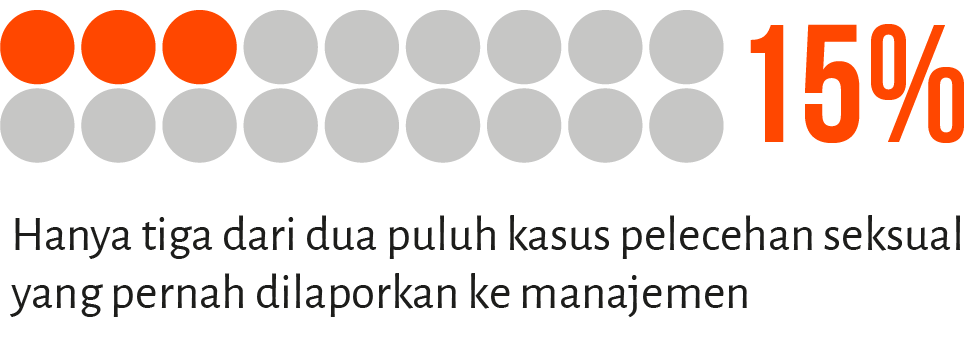
Minimnya pelaporan kasus kekerasan seksual kerap ditemui, baik di antara para karyawan maupun eksekutif perusahaan. Selain tingkat pelaporan 15% berdasarkan hasil survei terhadap responden, staf eksekutif perusahaan sendiri hanya melaporkan 33% kasus yang dialaminya (dari enam orang yang mengalami kekerasan seksual di antara 19 eksekutif, hanya dua yang melaporkannya).
Kita memang berharap ada tindakan yang harus diambil, tetapi karena hanya ada 42% staf eksekutif yang menyatakan memahami kebijakan perusahaan terkait kekerasan seksual, hasilnya sudah dapat ditebak.
Dari hasil wawancara tambahan dengan 19 staf eksekutif media, ditemukan bahwa
Meningkatkan pengetahuan tentang kebijakan terkait kekerasan seksual beserta cara penerapannya menjadi langkah awal untuk meningkatkan jumlah kasus yang ditindaklanjuti. Mengingat hanya ada tiga dari delapan staf eksekutif yang mengetahui tentang kebijakan ini dan dilatih secara pribadi untuk dapat menerapkannya, upaya ini dapat berdampak besar. Upaya ini dipertegas dengan adanya setengah lebih dari para staf eksekutif yang menyatakan perlunya lebih banyak sosialisasi terkait jenis-jenis kekerasan seksual dan cara menindaklanjutinya.
Responden survei menyebutkan bahwa pelaku kekerasan yang mereka alami merupakan rekan kerja (dalam 35,2% kasus), sedangkan dalam 18,6% kasus, pelaku merupakan manajer tingkat atas dan dalam 12,7% kasus, merupakan atasan langsung.
“Dari hasil penelitian, diketahui bahwa ada ketidaksepakatan terkait prevalensi kekerasan seksual dalam perusahaan media. Sebanyak 73,6% staf eksekutif yakin kekerasan seksual bukanlah persoalan dan menurut 10,5% eksekutif lainnya, sudah tidak menjadi persoalan di masa kini. Pendapat ini sangat berbanding terbalik dengan kenyataan bahwa hanya satu dari tiga perempuan sekaligus 4% laki-laki mengalami suatu bentuk pelecehan di tempat kerja,” ujar Melanie Walker, Direktur Eksekutif Pengembangan Media untuk Women in News WAN-IFRA.
“Situasi tersebut cukup pelik karena langkah pertama untuk mengatasi kekerasan seksual adalah memahami apa itu kekerasan seksual dan menerima bahwa persoalan ini nyata. Kami senang para staf eksekutif sepakat bahwa sosialisasi perlu digiatkan pelaksanaannya guna meningkatkan pemahaman terhadap kekerasan seksual sekaligus cara mengatasinya. Kami yakin bahwa melanjutkan kemitraan dengan berbagai perusahaan media di Asia Tenggara akan membantu mengatasi ketidaksepakatan atau kesalahpahaman.”
Women in News yang baru saja hadir di Asia Tenggara mampu memberikan sudut pandang para ahli terkait cara mengatasi kekerasan seksual. Melalui kerja sama erat dengan berbagai perusahaan media dan individu lewat program Leadership Accelerator (akselerasi untuk pemimpin masa depan), manajer dan karyawan dapat dibekali dengan kebijakan dan prosedur agar mampu secara aktif mengatasi persoalan ini. Akan tetapi, yang lebih penting adalah tiap karyawan dapat lebih mudah untuk memahami hak-haknya dan perusahaan media memahami tanggung jawabnya. “Perjalanan masih panjang, yang dimulai dengan membentuk suatu pemahaman bersama tentang definisi kekerasan seksual dan alasan persoalan ini terus-menerus ada. Memberantas persoalan ini dari tiap perusahaan media akan mewujudkan lingkungan kerja yang lebih aman dan dapat mendukung perempuan untuk berkembang,” kata Khin Thandar Htay, Direktur WIN untuk Asia Tenggara.
Penelitian ini membuktikan bahwa perusahaan media perlu mengenali skala persoalan kekerasan seksual dan merencanakan langkah-langkah yang diperlukan untuk mewujudkan lingkungan kerja yang lebih aman.
“Upaya ini dimulai dengan diskusi terkait perilaku apa saja yang pantas dan tidak pantas dilakukan di perusahaan media masing-masing dengan secara jelas membahas masalah kekerasan seksual, termasuk menjelaskan definisinya dan perilaku apa saja yang tidak pantas, serta mengumumkan bahwa tiap karyawan berhak diperlakukan setara. Kebijakan saja tidak cukup; para karyawan dan manajer harus mendapat sosialisasi tentang prosedur yang bisa digunakan untuk menyampaikan dan meneruskan pengaduan. Tiap orang harus memahami konsekuensi dari kekerasan seksual. Lebih baik bertindak proaktif dan siap sejak dini ketimbang harus mengatasi krisis saat kasus muncul,” tegas Walker.
Women in Russian media are four times more likely to experience sexual harassment than men. A report on the scale of sexual harassment in Russia has shown how pervasive it is, yet just one-quarter of cases are ever reported to the management.
The research, commissioned by the World Association of News Publishers’ (WAN-IFRA) Women in News programme found that of those women media professionals who experienced harassment, 31% experienced verbal harassment and 14% experienced physical attacks. 22% of media professionals (men, women and gender non conforming individuals) report to experiencing harassment or some kind.
The survey, which is part of a multi-region study undertaken in partnership with City, University of London, set out to collect data on the scale of sexual harassment in media organisations in Russia, and to establish what was being done to provide safer newsrooms. 176 media professionals were surveyed. Supplementary in-depth interviews were conducted with 16 media executives.
WIN has been engaging with journalists and media managers on sexual harassment for more than 10 years. In that time, we have collected plenty of anecdotal evidence of sexual harassment. But this is the first time we have been able to draw on large-scale data to support the belief that it is prevalent everywhere and is a significant impediment to a healthy media industry, regardless of country or cultural context.
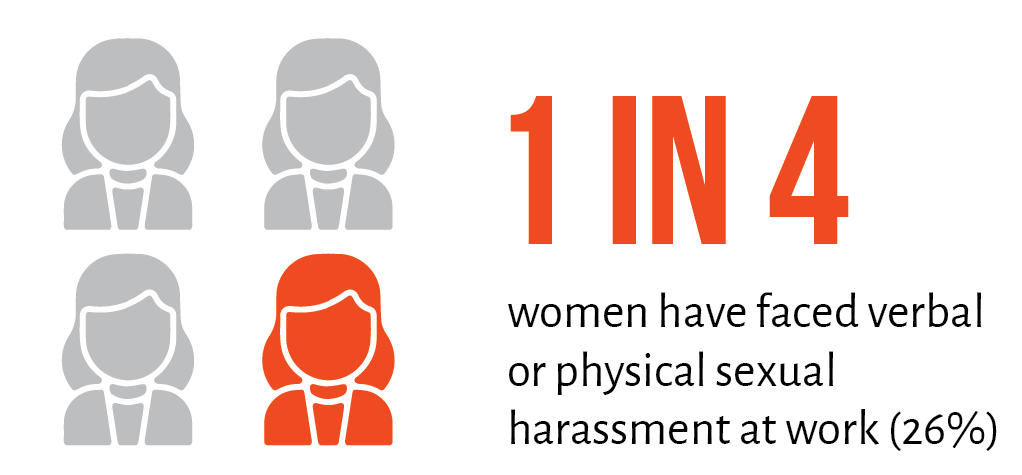
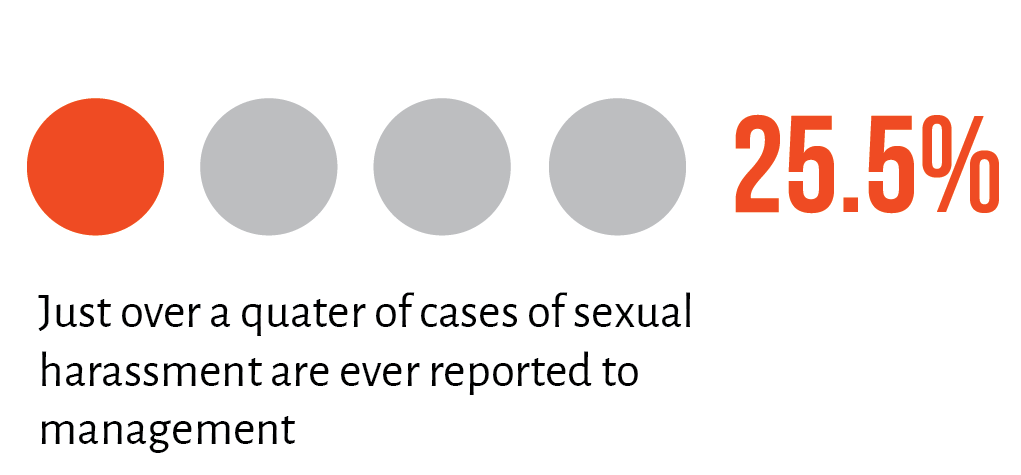
While sexual harassment in newsrooms for women is much more prevalent, men have not been spared.- though they are four times less likely to experience it than women, of those surveyed, 12 per cent had experienced verbal sexual harassment. None of them had been physically harassed.
Overall, just under one in four respondents (23.4%) had witnessed at least one incident of sexual harassment at work – but reporting of these cases remained low at 25.5 per cent.
The survey found:
In Russia, an average of 25.5% of cases of sexual harassment were reported to the management at media organisations. While 62% of these result in action by management, the low reporting rate means the majority of perpetrators are never disciplined and survivors never receive support.
Fear - fear of losing a job, negative repercussions, retaliation or being negatively labelled - was the prevailing reason for not reporting. Combined, it represents 39.7% of responses.
The top individual reasons \were no known reporting mechanisms (17.1%) and not thinking it was a big deal (15.3%).
Further, when respondents did report sexual harassment, news organisations took action less than two-thirds (62%) of the time. The most common responses from organisations when they took action were:
Direct action against the perpetrator almost never occurred. Firing, transfer, and suspension of the perpetrator were each only reported one time. The most common source of sexual harassment were fellow employees, followed by management (34.2%, combined total of direct supervisor and higher management).
“Understanding abuse of power is crucial to understanding who sexual harassment happens to and why. It tends to have nothing to do with sincere sexual or social interest. Instead, it happens where there are unequal relationships, for example between a superior and their subordinate, or between an older employee and a younger employee,” Melanie Walker, Executive Director, WAN-IFRA Women in News.
When asked if sexual harassment is an issue in the news industry, 15 news executives responded no, and one said maybe. This is in stark contrast to the 35% of women who reported experiencing verbal sexual harassment and 17% who reported experiencing physical harassment. This gap may also explain why 35% of responses said that organisational barriers, such as no reporting mechanism, not knowing how to report or thinking they wouldn’t be believed, were why they didn’t report the harassment they experienced.
To understand management perspectives on the prevalence of sexual harassment, WIN interviewed 16 managers and executives: 11 were women and five were men.
Three women stated they had experienced sexual harassment, but none had reported this.
The consensus between the news executives was that sexual harassment may occur in Russia in general, but it was an issue to be reported on, not one that was experienced by news personnel.
“I don’t think sexual harassment is a problem. If an issue arises, staff know how to defend themselves. Moreover, I have women who will fight back against anyone if this happens. We are all in a transparent environment; we see each other,” said one editor-in-chief.
“It is difficult for me to answer this question unequivocally. The honest answer: more likely yes than no,” said a deputy editor-in-chief.
When asked if any of their employees had reported cases of sexual harassment to them, three of the 16 executives answered yes, and their response was to discuss the incident with those concerned.
On reduced complaints, one CEO said: “Since the beginning of the #MeToo movement, many men have been rethinking their actions. Nonetheless, I remain concerned about sexual harassment and realise we can do better.”
Interestingly, when we asked respondents if their work environment was supportive, for women, 76.2% somewhat to strongly agreed they could openly talk to their supervisor, 88.1% somewhat to strongly agreed they felt listened to at work, and 88.8% somewhat to strongly agreed they felt safe in their newsroom. This seems to be in contrast to their experiences.
In response to a question on whether or not the executives believed their employees felt comfortable reporting sexual harassment incidences to their news organisations, 12 said yes.
“I’m sure about the women. They certainly would tell. They always talk about their problems: from health problems to personal dramas and breakups. With men, I’m not so sure. A man should deal with his problems on his own - this is the Russian mentality. You’re not a man if you show your weakness or ask for help,” said one general director.
Executives’ beliefs that sexual harassment is a non-issue in their workplace contrast with the respondents’ views, where one in four women have experienced either unwanted verbal or physical harassment at work.
Respondents said the perpetrator was most likely a fellow employee but that they do receive significant unwanted attention from people in power in the organisation - namely supervisors and executives.
The overarching stand from managers that there was no need for explicit sexual harassment policies and procedures may explain why reporting is low. A common reason for not reporting was dismissing the event as no big deal. However, one respondent pointed to a feeling of shame around verbal harassment, in line with cultural norms that silence victims.
Additionally, when asked if they knew if their organisations had an anti-sexual harassment policy, of the 16 news executives, only two were aware of such a document. And when asked to provide suggestions for eliminating sexual harassment in the news industry, they focused on the importance of communication in creating a comfortable atmosphere. Most executives believe this exists in their workplace, therefore, sexual harassment is not a significant issue.
The research findings go beyond anecdotes and demonstrate that sexual harassment does exist in Russian media organisations. The managers’ confidence that their workplaces, with their open communication policies, are not hotbeds for harassment, feeds into the notion that sexual harassment is a problem of the past and continues to create unsafe work environments for all of their staff.
The first step is making sure executives really understand what constitutes sexual harassment and just how pervasive it is. Only from there can policies be enacted and working cultures change to stamp out this scourge from all media organisations and, ultimately, all workplaces in general.
“The study showed that many publishers try to create an open, friendly atmosphere in their newsrooms and sincerely believe that this protects against harassment. But incidents can happen in any team and in any organization. It is important to know what to do and how to proceed in this case in order to protect people. You should have the reporting mechanisms, the investigative procedures and rules, the understanding of actions in response. The study revealed they do not exist, or employees do not know about them. Together with WIN WAN-IFRA, ANRI-MEDIA is taking very first steps in this direction to help media outlets create a safe business environment. For example, we adopted a WIN Guide on countering harassment in the media with practical templates and recommendations." Anna Koshman, ANRI-Media
Although 85% of sexual harassment incidents go unreported in the Arab media industry - management is starting to take some concrete actions to break the circle of silence.
526 media professionals participated in a survey from February to April 2021 distributed in Egypt, Jordan, Lebanon, and Palestine as part of a multi-region study to provide evidence of sexual harassment in the media industry. Just over half of the participants were women (54%).
On average one in three women have faced some form of sexual harassment at work (35%). More than 50% have experienced verbal harassment. Yet only 12% of incidents are reported. Men are more likely to see action taken on their behalf. On average, 50% of cases reported by men received action from their organisation, compared to 41% for women.
In addition, when asked if their organisation has an anti-sexual harassment policy, only 7% said there is one in place and they are aware of it.


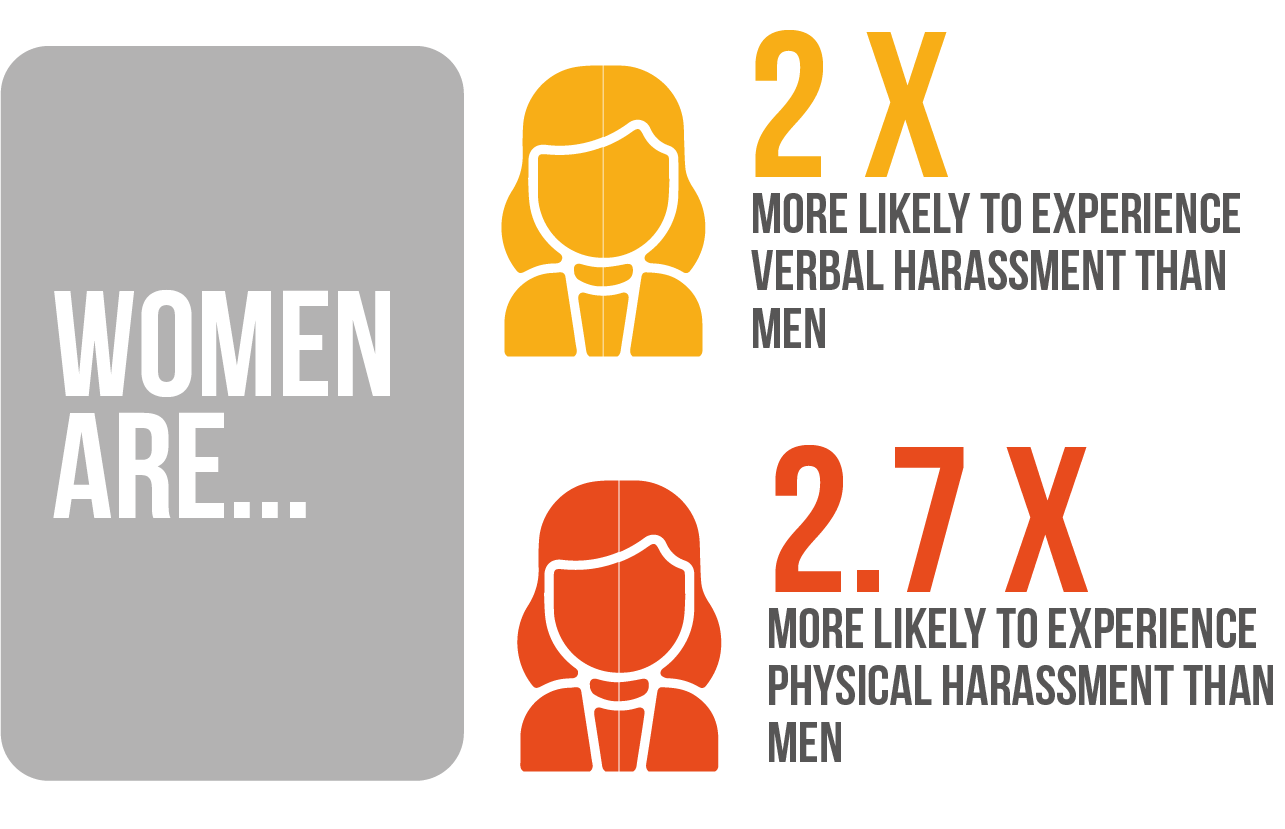
When respondents were asked questions on types of sexual harassment they faced at work women were almost twice as likely to experience verbal harassment compared to men, 52% and 24% respectively. The gap expands more when comparing data on physical harassment (19% and 7%).
Though a small sample size, of respondents who did not specify their gender in the study (almost 15% of the total responses), 29% experienced verbal sexual harassment, 14% experienced physical sexual harassment.
Furthermore, one in two participants stated that they have witnessed sexual harassment - 13.5% five or more times.
The results of this study reveals that sexual harassment is still existing, profoundly, in the media sector, which stresses the need and importance of taking actions to deal with it in an effective way.

Underreporting of sexual harassment is endemic. Providing safe space to talk freely about those cases, and guaranteeing confidentiality and protection are needed, in addition to raising the awareness of speaking up, showing the added value of protecting others from witnessing such recurrent situations.
Yet, of those reported cases, news organisations took actions 46% of the time, a step forward to activate the organisational role in ensuring safety and security of employees at the work environment.
The top reasons listed for not reporting were no known reporting mechanism available (17.3%), not having evidence (13.8%), and not wanting to be negatively labelled (12.8%). The most common responses of organisations when they took action was firing the accused (24.5%), and dismissing with no further action (20.5%).
The reasons for not reporting are brilliantly revealing the way to increase reporting rates: adapt a clear and comprehensive mechanism that applies fair rules, which help change the organisational culture to embracing openness and transparency instead of shame and blame paradox.
AR respondents revealed that the most common source of sexual harassment was a fellow employee (42.9%), followed by direct supervisor (22.2%), higher management (14.6%), other (10.7%), and news source (9.5%).
Numbers show that most sexual harassment incidents happen inside the media organisations at work, whether by the same level of management employees or higher. Firm procedures to help all staff members enjoy a safe workplace is a must.
Penelitian ini membuktikan bahwa perusahaan media perlu mengenali skala persoalan kekerasan seksual dan merencanakan langkah-langkah yang diperlukan untuk mewujudkan lingkungan kerja yang lebih aman.
“It all starts with a conversation on what is and isn’t acceptable behaviour in your media organisation. - being explicit about sexual harassment - sharing definitions, what behaviours are unacceptable, and communicating the right for every employee to be treated equally. It is not enough to have a policy; staff and managers must be trained on what the procedures are for making and managing a complaint. Everyone should be clear about the consequences of sexual harassment. It is far better to be proactive and prepared than pushed into a crisis management position when a case emerges,” said Melanie Walker, Executive Director, WAN-IFRA Women in News.
The media industry in Nicaragua and El Salvador has a sexual harassment problem. On average, 74% of women in media have experienced verbal sexual harassment. More than 40% have experienced physical harassment. These are amongst the highest rates of sexual harassment of all countries surveyed in the 20-country study, completed in November 2021.
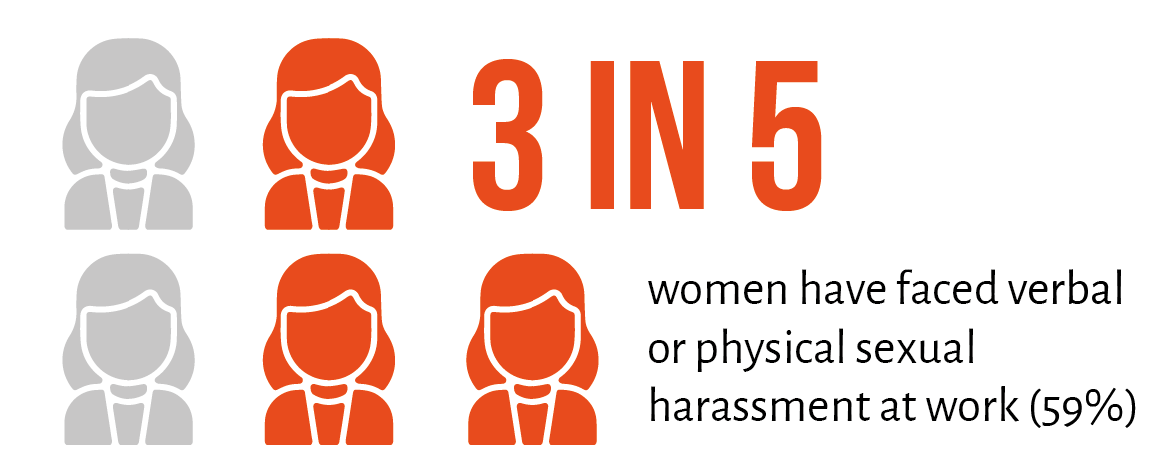
234 media professionals in Nicaragua and El Salvador participated in a survey, in addition to 18 media executives who provided supplementary in-depth interviews to understand the extent of sexual harassment in the industry.
The data shows that women are disproportionately affected, experiencing verbal and physical sexual harassment at least four times more than men. Moreover, women experience sexual harassment far more often than men, with almost half of the women surveyed indicating they have experienced verbal sexual harassment five times or more, compared to 5.8% of men.

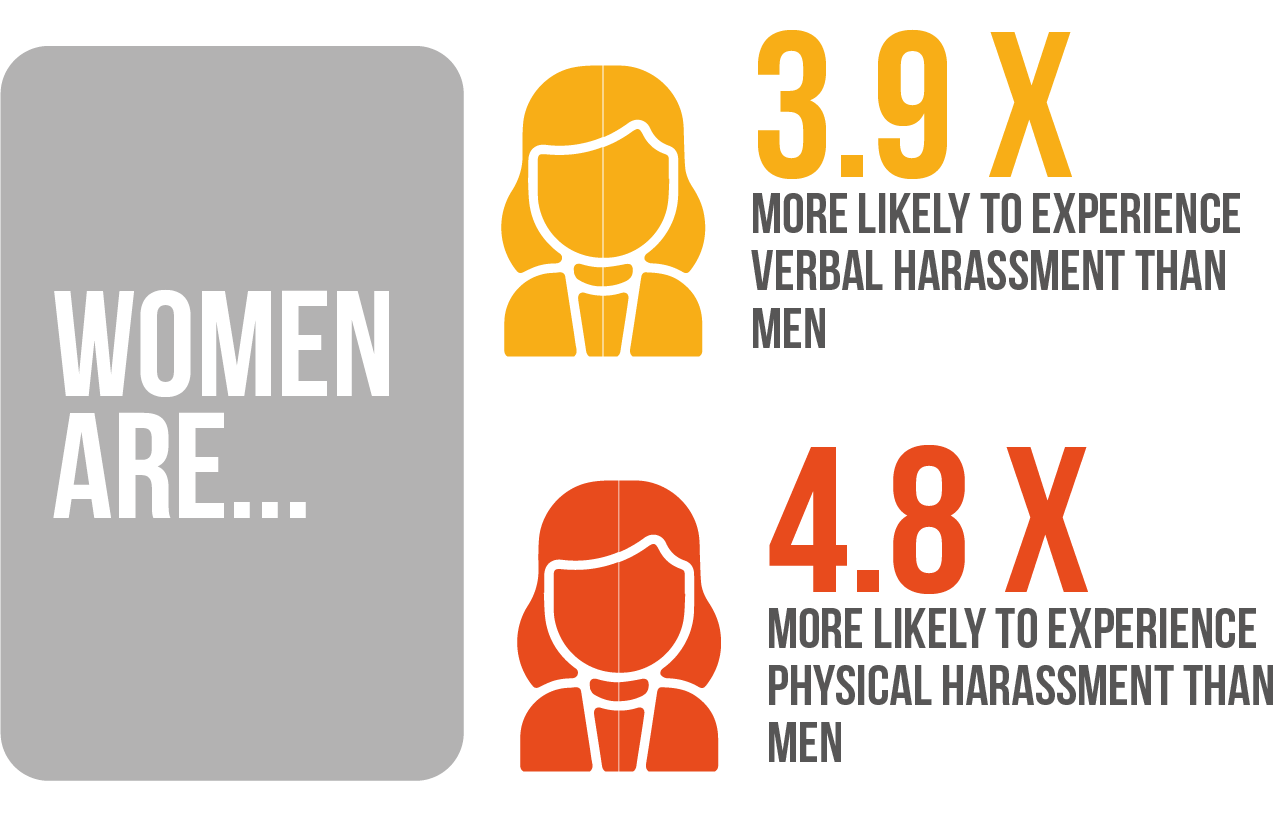
Given these high figures, it is not surprising that almost 60% of the participants had witnessed at least one incident of sexual harassment with 21% stating they had seen five or more. The most common source of sexual harassment was a fellow employee (42%), followed by higher management (25%).
Despite the high prevalence of sexual harassment, on average only one in every four cases was reported. Action was taken in just under half (46%) of incidents that were reported. Responses from both survey participants and news executives indicated the lack of a known sexual harassment policy. This is reflected by the survey respondents, where the top reasons for not reporting cited were ‘no known reporting mechanism available’ and ‘not knowing how to report’. The other reasons for not reporting were ‘fear of perpetrator retaliation’ or ‘fear of a negative impact in their professional career’.

Interestingly, when the interviewed news executives were asked if sexual harassment was a problem, the majority said yes, but not in their newsroom. More than half of the news executives interviewed stated that their newsrooms were exceptions to the overall atmosphere in the news industry, were sexual harassment was common.
The most common responses of organisations when they took action was warning the perpetrator (56.4%), offering emotional support for the victim (16%), and the victim being transferred to another department (10.3%).
Media organisations in Central America need to recognise the extent of sexual harassment and put in mechanisms to provide a safer working environment. The research shows that sexual harassment is a significant problem. The lack of policies aimed at preventing sexual harassment and at addressing it properly when it occurs, along with the common fear to report results in high levels of sexual harassment in the Central American media industry that go largely unchecked.